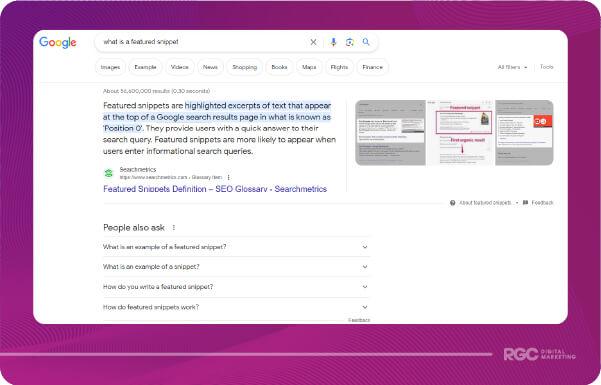These days, most of us use Google as our personal assistant. We rely on search engines to fill in the gaps for us, improve our knowledge and give us insight into the things we care about. And we do it more than you probably realise.
Think about it.
Have you ever found yourself watching a blockbuster film and wondered how old the lead actor is? Or maybe you’ve been in the mood for a new meal to cook over the weekend. What did you do in that situation?
Chances are that you asked Google, and it’s likely that you would’ve found that actors age or discovered that amazing recipe without clicking on a single website. Sound familiar?
This is known as a “zero-click search”, and they’re becoming more common than you’d believe. But how many searches are zero click? More than half of all searches end without another click.
This trend towards instant answers is great for users because it gives them the answers they need in the blink of an eye. And users what to know how to get value from zero click searches. But how can this work alongside your SEO strategy? How can you optimise for zero click searches? In this article, we’ll explain exactly how you can alter your SEO efforts to make sure you make your mark in today’s ever-evolving digital world with quality zero click content.
Craft Your Content For Rich Snippets
If you’re ready to embrace zero-click SEO and work towards achieving the first answer users see, you’ll need to secure featured snippets. These pieces of content are special features on search results pages that show more detailed information than typical results to answer a query as quickly and accurately as possible.

While they may not generate many clicks, it might be impossible for your business to avoid all keywords that generate featured snippets, especially if they’re closely related to the services you offer. In these cases, your focus might shift from generating clicks to increasing brand awareness and improving your visibility.
To alter your content strategy to ensure you have a chance at being picked for featured snippets, follow these steps:
Answer Questions Directly:
Write clear and concise answers to common questions. Think of the “who,” “what,” “where,” “when,” and “why.” This can be very important in answering FAQs within the “people also ask” section of SERPs for zero-click SEO results.
Use Structured Data:
This is a bit technical, but it’s about marking up your website’s content in a way that search engines can easily understand. Tools like Google’s Structured Data Markup Helper can guide you.
Proper Content Formatting:
The way you format your content can influence the type of featured snippet you earn. Whether it’s a paragraph, list, table, or video, ensure your answers are concise, approximately 40-50 words or 250-300 characters. The trick is to be succinct while providing value.
Incorporate Relevant Images:
Ensure images in your content match the ideal dimensions for featured snippets. Although Google might select its own images, optimising yours increases the chances they’ll be chosen. Aim for images that are roughly 160 x 200px, but remember they can be scaled up for clarity.
Harness The Power of Long-Tail Keywords
Picture this. You’re looking to buy a new pair of hiking boots, and you’ve just walked into a shop that sells the style you’re looking for. Imagine walking into that enormous shop with thousands of pairs of shoes and, in an attempt to find those shoes, you ask the shop assistant to be directed to the shoes.
You’d be shown countless options, and very few of them would even be close to what you’re looking for. Now imagine asking for “men’s waterproof hiking boots”. In this case, you’d be pointed exactly where you want. That’s the idea behind long-tail keywords.

Long-tail keywords are more detailed, specific search phrases that users employ when they’re closer to making a purchase or finding an exact answer to a highly specific question. They’re the opposite of broad, generic terms and they often form an integral part of digital marketing strategies. These specific keywords help businesses truly hone in on their niche, standing out in the crowded digital marketplace.
Why are they game-changers? Well, they’re typically less competitive, which means you have a better shot at securing the prime “position zero” for zero-click SEO. And, while they might get fewer searches, they often have a higher conversion rate. Why? Because they cater to people looking for precise information or products.
To make the most of long-tail keywords, follow these tips:
Use Research Tools:
Tools like SEMrush are goldmines for uncovering these keywords. They offer insights into what your target audience is searching for, allowing you to tailor your content effectively. Use them regularly to stay updated on trending long-tail searches.
Understand User Intent:
Beyond just finding keywords, it’s crucial to grasp the “why” behind them. Are users looking to buy, to learn, or simply to compare? This is crucial in optimising for zero click searches.
Craft Quality Content:
Once you have your long-tail keyword list, focus on creating quality content that genuinely satisfies those queries. Dive deep into the topic, offering comprehensive, well-researched information. This helps to establish you as an authority in your niche.
Simplify Your Content For Voice Search
“Hey Google, where’s the nearest coffee shop?” We’ve all heard that before. This is voice search in action. With the rise of smartphones and smart speakers, voice search has become a staple of our constant desire for knowledge. And naturally, these searches aren’t always lodged when users are looking at a screen, so to satisfy the user’s requirements, they often result in zero-click searches.
If your business neglects voice search, you could be missing out on a huge chunk of potential audience interaction. As people lean more towards hands-free searches, ensuring your content is voice-search-friendly is essential.

Here’s how to optimise for voice search:
Focus on Natural Language:
Voice search is conversational. Use phrases and terms that people would say out loud. Avoid jargon; instead, think about how you’d explain a topic to a friend.
Prioritise Location:
Many voice queries are location-specific, and that’s why local SEO has become so important. Ensure your business name, address, and phone number are consistent across all online platforms. Linking your content to local landmarks or events can also enhance its relevancy.
Opt For Clear, Concise Answers:
Devices tend to pick the clearest answers for voice responses. Craft content that provides the direct answers required in today’s zero-click SEO environment. Create FAQ sections or short, informative paragraphs that can easily be used for voice responses.
Adapting to a Zero-Click Future
The digital landscape is ever-evolving, and the rise of zero-click SEO and zero click searches is a testament to that change. For businesses, it’s no longer just about securing the click; it’s about being present, visible, and memorable. In a world where the first answer might be the only one a user hears or sees, the emphasis should be on delivering unmatched value, bolstering your brand, and fostering trust.
Don’t look at zero-click SEO as a challenge. Think of it as a new opportunity to reaffirm your business’s authority and expertise. As we delve deeper into this zero-click era, businesses must prioritise genuine value and impactful presence over click metrics. Embrace the shift, and let your brand’s voice be heard.


